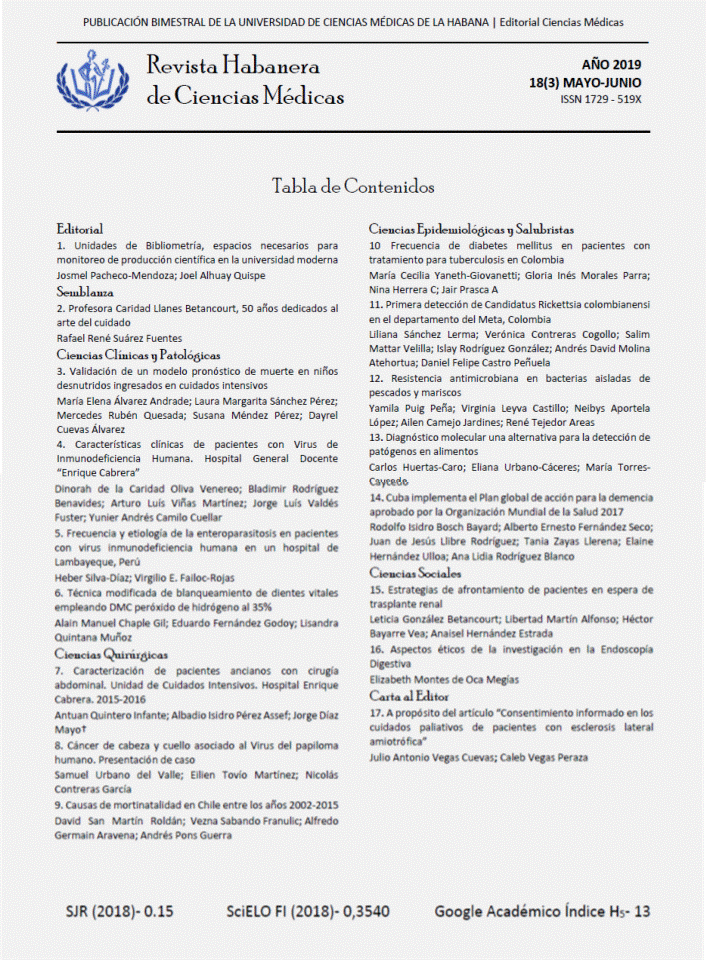Cancer de cabeza y cuello asociado al Virus del papiloma humano. Presentación de caso
Palabras clave:
Neoplasia, cirugía, histopatología, papillomaviridae, conducta sexual.Resumen
Introducción: El carcinoma de cabeza y cuello actualmente tiene la sexta incidencia más alta en todo el mundo. El Virus del papiloma humano (VPH) es un virus de ácido desoxirribonucleico (ADN) pequeño con más de 200 subtipos, se han reportado características notables en cáncer de cabeza y cuello según el estado del VPH. Histopatológicamente, el cáncer con VPH positivo tiende a ser menos diferenciado de tipo basaloide y queratinizado.
Objetivo: Exponer la relación del cáncer de cabeza y cuello asociado a la presencia del virus del papiloma humano, subtipos 16 y 18, en un paciente joven, describiendo el abordaje quirúrgico realizado, y presentar los resultados del ejercicio clínico teniendo en cuenta la estadificación, profundidad de la invasión, tratamiento recibido, y valorar el resultado oncológico y la satisfacción estética y funcional del paciente.
Presentación del caso: Se presenta el caso de un paciente masculino de 40 años de edad, sin antecedentes de consumo de tabaco, con consumo ocasional de alcohol; comenta practicar hábitos sexuales orogenitales en relaciones bisexuales, refiere además antecedentes de cáncer en la familia. Presenta úlcera localizada en borde lateral de lengua. El diagnóstico histopatológico indicó carcinoma escamocelular infiltrante de célula grande queratinizante.
Conclusiones: Los factores de riesgo asociados como el tabaquismo y consumo de alcohol son determinantes en el desenlace de este carcinoma, por lo que el diagnóstico y la progresión de la enfermedad en este grupo de sujetos VPH positivos, requiere un abordaje distinto al comúnmente implementado.
Palabras claves: Neoplasia, cirugía, histopatología, papillomaviridae, conducta sexual.
Descargas
Citas
1. Pytynia KB, Dahlstrom KR, Sturgis EM. Epidemiology of HPV-associated oropharyngeal cancer. Oral Oncol [Internet]. 2014 [cited: 11/03/2019]; 50(5):380-386. Available from: https://www.ncbi.nlm.nih.gov/pmc/articles/PMC4444216/
2. Mallen-St Clair J, Alani M, Wang M. Srivatsan E S. Human papillomavirus in oropharyngeal cancer: The changing face of a disease. Biochimica et Biophysica Acta (BBA)-Reviews on Cancer, 2016; 1866(2):141-150.
3. Jamieson L, Garvey G, Hedges J, Mitchell A, Dunbar T, Leane C, Roder D. Human Papillomavirus and Oropharyngeal Cancer Among Indigenous Australians: Protocol for a Prevalence Study of Oral-Related Human Papillomavirus and Cost-Effectiveness of Prevention. JMIR research protocols. 2018; 7(6): e10503.
4. Wagner S, Sharma SJ, Wuerdemann N, Knuth J, Reder H, Wittekindt C, Klussmann J, P: Human Papillomavirus-Related Head and Neck Cancer. Oncol Res Treat [Internet]. 2017 [cited: 11/03/2019];40:334-340. Available from: https://www.karger.com/Article/Pdf/477252
5. Young D, Xiao C C , Murphy B, Moore M, Fakhry C, Day T A. Increase in head and neck cancer in younger patients due to human papillomavirus (HPV). Oral oncology [Internet]. 2015 [cited: 11/03/2019]; 51(8):727-730. Available from: https://www.sciencedirect.com/science/article/abs/pii/S1368837515001827?via%3Dihub
6. Derek B, Maleki Z. HPV-related head and neck squamous cell carcinoma: An update and review. Journal of the American Society of Cytopathology [Internet]. 2016 [cited: 11/03/2019]; 5(4):203-215. Available from: https://www.sciencedirect.com/science/article/pii/S221329451530003X
7. Nulton T J, Kim N K, DiNardo L J, Morgan IM, Windle B. Patients with integrated HPV16 in head and neck cancer show poor survival. Oral oncology [Internet]. 2018 [cited: 11/03/2019]; 80:52-55. Available from: https://www.sciencedirect.com/science/article/pii/S1368837518301179
8. Mydlarz W K, Chan JY, Richmon J D. The role of surgery for HPV-associated head and neck cancer. Oral oncology [Internet]. 2015 [cited: 11/03/2019]; 51(4):305-313. Available from: https://www.sciencedirect.com/science/article/abs/pii/S1368837514003005
9. Ellis M. A, Graboyes E M, Wahlquist A. E, Neskey D. M, Kaczmar J. M, Schopper H. K, Day T. A. Primary surgery vs radiotherapy for early stage oral cavity cancer. Otolaryngology–Head and Neck Surgery [Internet]. 2018 [cited: 11/03/2019]; 158(4):649-659. Available from: https://journals.sagepub.com/doi/abs/10.1177/0194599817746909#articleCitationDownloadContainer
10. Walvik L, Svensson A. B, Friborg J, Lajer C B. The association between human papillomavirus and oropharyngeal squamous cell Carcinoma: Reviewed according to the Bradford Hill criteria for causality. Oral oncology [Internet]. 2016 [cited: 11/03/2019]; 63:61-65. Available from: https://www.sciencedirect.com/science/article/abs/pii/S1368837516302111
11. Rettig E M, Zaidi M, Faraji F, Eisele D. W, El Asmar M, Fung N, Fakhry C. Oropharyngeal cancer is no longer a disease of younger patients and the prognostic advantage of Human Papillomavirus is attenuated among older patients: Analysis of the National Cancer Database. Oral oncology [Internet]. 2018 [cited: 11/03/2019]; 83:147-153. Available from: https://www.sciencedirect.com/science/article/abs/pii/S136883751830232X
12. Bansal A, Singh M. P, Rai B. Human papillomavirus-associated cancers: A growing global problem. International Journal of Applied and Basic Medical Research [Internet]. 2016 [cited: 11/03/2019]; 6(2):84-89. Available from: https://www.ncbi.nlm.nih.gov/pmc/articles/PMC4830161/



